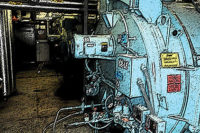Hospitals consume approximately 5% of the total energy use in the United States. That equates to 458 trillion Btus (Commercial Building Energy Consumption Survey [CBECS]). Hospitals spends approximately $5 billion on energy per year, or 1-3% of its operating budget (Department of Energy). Reducing the operational cost of most health care systems is very important to meet the C-Suite Triple Aim and now the new “Quadruple Aim.”
Most of the energy consumed by health care systems arise from the heating and air conditioning systems. Chiller plants are the single largest consumer of energy in most health care facilities. This energy use can be exacerbated if the system is not design to operate at its maximum efficiency. Many health care facilities are 24-hour operations, and therefore chiller plants operate every day all year round. Therefore, making the chiller plant more efficient is one of the greatest means of reduction of energy use for large health care systems.
Chillers generally achieve maximum efficiency when they operate between 65% and 85% of its full load capacity. Chillers operating below 50% of their rated load are usually associated with very large energy consumption and poor energy performance. Therefore, the chiller operational efficiency under variable load is the key to energy saving for a chilled water plant. Chillers should be designed to operate between 60% and 80% of their rated capacity range in order to maximize the energy savings for a chiller plant. On that premise, this article will discuss how a health care facility can maximize its chiller system performance and enhance operational cost.
Chiller Optimization
By reviewing the normal operating loads and parameters, health care facilities can create an economic dispatch algorithm that can optimize the starting and stopping of chiller plant equipment. The goal of creating the algorithm is to consistently run each machine within its ideal performance range, thus optimizing the overall system efficiency for a given chiller system demand. This is undoubtedly a very complicated process, and it may not appeal to facilities managers who wish to keep things as simple as possible, but the trade-off for complexity is a significant opportunity for savings. This can be done by writing an optimization sequence of control that can be implemented by a control contractor and controls manufacturers. This type of control mechanism requires a significant amount of programing and modification to an existing plant and can be very expensive and complex to implement.
An alternative and more effective way of achieving chiller plant optimization is the application of the Hartman Loop technology that is available from multiple control manufacturers. The Hartman Loop technology is not new to the industry and has been patented since 2001. This technology will not allow the various components (chiller, tower, and chilled water distribution pump) to act as independent components, but it enables the total system to operate together as a single system.
Chilled water and condenser water temperatures are not controlled directly in this high-performance operating concept. Instead, each component is operated such that its performance is optimized with respect to all other components and the requirements of the current load conditions of the system. The main motivation behind the technology is maximizing the value of the variable speed technologies that are now a part of all chiller systems. The result is annual energy consumption that can be below 40% to 50% percent of a traditionally designed high-efficiency chiller plant in hospitals.
As a designer, I have designed and specified the optimization package for many chiller plants, but less than half have been installed due to the high first cost of implementation. This is not entirely surprising given the tough financial climate that health care systems are experiencing. These budget constraints force projects to focus on first cost and not the low longer-term operational cost. Health care project managers should pay more attention to the lifecycle cost of the optimization packages. The calculated payback is often less than five years. Where sufficient expertise is not available, in-house the facility managers should consider working with reliable controls partners and mechanical control engineers to assist them in the implementation of a chiller optimization package.
Chilled Water Plant Equipment
There are many factors to consider besides the chiller itself when trying to optimize the chilled water plant. Auxiliary equipment, such as cooling towers and pumps, has a huge impact on the efficiency of the chiller operation. When looking at chiller plant optimization, you have to examine the individual components and how their interaction will affect the entire system. In addition to combined equipment capacity, several other factors will influence the system’s ability to meet the building cooling load. Some of the factors are the type of refrigerants, operating hours, weather conditions, electricity rates, and building use. These factors should all be examined in detail when trying to optimize the chiller system performance.
Chiller Technologies
Chiller technologies have improved tremendously over the past 20 years, resulting in newer chillers operating at higher efficiency than older model chillers. For example, chillers from the leading chiller manufacturers like Daikin, Trane, Carrier, and Johnsons Control have full load efficiencies of between 0.45 kW per ton and 0.5 kW per ton at AHRI conditions. These chillers also have integrated part load values (IPLVs) of between 0.29 kW per ton and 0.305 kW per ton. Newer magnetic bearing chillers such as Daikin Magnitude, Johnson Controls YMC2, and Multistack’s MagLev have integrated part load values as low as 0.29 kW per ton, which can be very attractive for new chiller plants.
Ten years ago, centrifugal and screw chillers had full-load efficiency ratings of 0.75 to 0.85 kW per ton. Ten years prior, the full-load efficiencies were in the range of 0.85 to 1.00 kW per ton. Based on these numbers, this means that newer chillers are operating at as much as 60% better than chillers that were manufactured and installed 20 years ago. This does not take into consideration reduced efficiencies that are associated with poor maintenance and normal wear and tear of existing chiller machines. New chillers should be selected not only on first cost but on lifecycle cost and overall equipment efficiencies.
Selecting a very efficient full-load chiller will not guarantee efficient chiller performance. Most chillers are operated at full load less than 5% of their total run time. The other 95% of the time, the chillers are operating at part-load efficiencies. Understanding the load profile of the new or existing system will help the designer to select the most efficient chiller for a chilled water plant. Chiller water plant optimization for most new systems starts with the right selection of the new equipment. Although it may cost more to purchase a chiller with better part-load efficiency, these incremental costs usually have a short payback period due to energy savings. Facility managers should work in tandem with their mechanical engineers to ensure that the right chillers are selected for their hospitals.
Chilled Water Supply Temperature Control
For years, chillers were controlled to supply constant temperature water to the hospitals regardless of cooling load. However, modern chillers can vary the chilled water supply temperature as the cooling load decreases. By allowing the water temperature to float up during low-cooling load periods, savings of about 1% per degree temperature rise are typical. Therefore, raising chilled water supply temperature by an average of 5ºF will save about 5% in chiller energy.
To do this, the chiller must somehow sense when there is reduced load. Sometimes, chilled water return temperature is used as an indicator (higher return temperatures indicate fewer cooling loads are being taken out of the loop, i.e. reduced load). More sophisticated systems will monitor the worst-case zone — the one with the most open cooling water valve. When the temperature of that zone starts to rise, chilled water temperature is lowered. Chilled water supply temperature control is an important subset of chiller plant optimization. However, this can be done as a standalone optimization or can be implemented as part of the chiller optimization package.
Condenser Water Temperature Setpoint Control
A condenser water reset approach can be applied to chiller plants with cooling towers where the condenser water temperature can be varied. Most cooling tower control sequences maintain a constant condenser water temperature (usually at 85ºF) by varying the flow rate of air. As the outdoor wetbulb temperature decreases, the condenser water temperature can be decreased. The result is less work for the compressors and a savings of about 0.5% for each 1ºF decrease in condenser water temperature.
Therefore, lowering condenser water temperature by an average of 5ºF will save about 2.5% in chiller energy. There are limits to how low you can go — check with your chiller manufacturer. Most chillers can handle temperatures of 70ºF or below. Again, this can be done as a standalone optimization or can be implemented as part of the chiller optimization package.
Dynamic Chiller Optimization
SmithGroupJJR has partnered with many health care systems to execute the dynamic chiller optimization (DCO) process. This process involves the gathering of real-time data from existing operational chiller water systems. Information on all the key conditions that affect comfort, energy, and intended performance is collected. This collected data is then used to create actionable measures which will help to optimize the operation of the chilled water plant. The application of DCO will allow many health care owners to save energy while helping maintain peak performance for the chiller plants.
The first step in implementing DCO for a chilled water plant is to record pre-baseline measurements to track existing chiller water system performance. Metering data will have to be collected. This is done by adding transducers to the cooling towers, all pumps, as well as trending for chiller energy use (kWh) to track system performance. The collected metering data will provide an accurate baseline to compare future performances.
One key benefit of using DCO is that it often helps to increase chilled water plant capacity and manage system problems. Implementing DCO can also address cooling tower capacity issues and over-pumping by implementing control sequences that can effectively and efficiently control the cooling towers. This can improve the cooling tower capacity by optimizing the chiller performance while reducing tower fan energy.
Conclusion
Chiller plant optimization is a major undertaking for the facility department because of its impact on the plant operation and the high first cost to the facility department. However, the economic impact of implementing such a system far outweighs the first cost and will help the hospital system to reduce its operating cost. The bottom line is that a chiller water plant optimization makes sense because it is contributes to the “triple/quadruple aim” of the health care system.
Recent improvement in chiller technology and efficiencies makes the decision easier for new chilled water plants, especially at a time when energy costs are ratcheting upward every day. For existing chiller plants, DCO should be implemented in order to reap the full benefits of the chilled water plant optimization.







